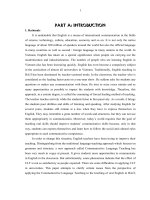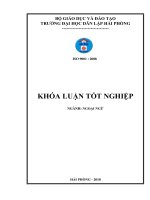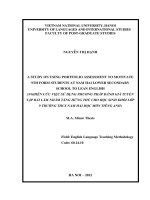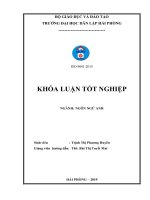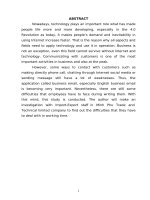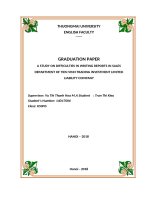A study on difficulties in learning Business Correspondence of thirdyear students at English Faculty, Thuongmai University
Bạn đang xem bản rút gọn của tài liệu. Xem và tải ngay bản đầy đủ của tài liệu tại đây (536.55 KB, 53 trang )
THUONGMAI UNIVERSITY
ENGLISH FACULTY
------
GRADUATION PAPER
TOPIC:
A STUDY ON DIFFICULTIES IN LEARNING BUSINESS
CORRESPONDENCE OF THIRD-YEAR STUDENTS AT
ENGLISH FACULTY, THUONGMAI UNIVERSITY
Supervisor
: Mrs. Nguyen Bich Hong, M.A
Student
: Le Thi Dieu Linh
Class
: K52N5
Student code : 16D170306
Hanoi - 2019
Hanoi - 2019
ACKNOWLEDGEMENTS
In the completion of this graduation paper, I have received valuable supports
and idea contributions from my teachers, my family and friends.
First of all, I would like to express my deepest gratitude to my supervisor,
Mrs. Nguyen Bich Hong, M.A for her gracious assistance, friendly support,
thoughtful advice, valuable comments, patience and warm encouragement
throughout my study. Without her whole-hearted help, my graduation paper would
not have been completed. Also, I am very grateful to all the teachers at the English
Faculty of Thuongmai University for their interesting and useful lectures during
four years which have built in me valid knowledge and necessary skills for my
fulfillment of this paper.
The completion of this study would not have been possible without the
cooperation from third-year English major students at Thuongmai University who
participated in the study. I am very grateful to all of them for providing useful
information for the analysis of this study.
Last but not least, I would like to give my sincerely thanks to my family and
my friends who always give me the encouragement and inspiration which helps me
overcome difficulties to fulfill my graduation paper.
Eventually, this research has been fulfilled to the best of my knowledge,
however, mistakes and shortcomings are unavoidable. Therefore, I would be
grateful if I receive appreciated comments and suggestions from readers for the
perfection of this graduation paper.
Hanoi, December 3, 2019
Student
Le Thi Dieu Linh
1
ABSTRACT
Business Correspondence plays an important role, it is also a compulsory
subject at university. In this study, the author would attempt to investigate the
difficulties in learning Business Correspondence of third-year English major
students at TMU, which consist of problems from learners (attitude toward learning
this subject), teachers (teaching methods) and curriculum (the completeness and
perfection). Besides, the errors in business letters written by students are also
detected. Based on data collected by questionnaires and accumulating some
business letters of students, the author would like to analyse so as to give objective
results performed in charts and tables particularly and the factors affecting learning
Business Correspondence. Then, the research would like to give some
recommendations and suggestions to deal with the difficulties in learning this
subject. Hopefully, this study is a useful reference source for students, who want to
improve their learning Business Correspondence and writing business letters skill as
well as enhance their academic results.
2
TABLE CONTENTS
ACKNOWLEDGEMENTS.....................................................................................i
ABSTRACT.............................................................................................................ii
TABLE CONTENTS.............................................................................................iii
LIST OF ABBREVIATIONS..................................................................................v
LIST OF IMAGES, TABLES AND CHARTS......................................................vi
CHAPTER 1: OVERVIEW OF THE STUDY......................................................1
1.1
Rationale........................................................................................................1
1.2
Previous studies.............................................................................................2
1.3
Aims of the study...........................................................................................4
1.4
Research subjects...........................................................................................4
1.5
Scope of study................................................................................................4
1.6
Research methodology..................................................................................4
1.7
Organization of the study..............................................................................5
CHAPTER 2: LITERATURE REVIEW...............................................................6
2.1 Background knowledge of Business Correspondence.....................................6
2.1.1 Meaning of Business Correspondence............................................................6
2.1.2 Importance of Business Correspondence........................................................6
2.1.4 Types of Business Correspondence.................................................................8
2.1.5 Parts and form of a business letter..................................................................9
2.1.6 Several types of business letters.....................................................................14
2.2 Points to remember when writing a bussiness letter.....................................15
2.3 Essential qualities of business letters..............................................................16
2.3.1 Inner quality..................................................................................................16
2.3.1 Outer quality....................................................................................................18
CHAPTER 3: RESEARCH FINDINGS..............................................................20
3.1 Data analysis....................................................................................................20
3.1.1 Data collected by the questionnaires.............................................................20
3.1.2
Data collected by accumulating students’ bussnines letters.....................30
3.2 Discussion about difficulties of the students in learning Business
Correspondence.....................................................................................................33
3
CHAPTER 4: RECOMMENDATIONS AND SUGGESTIONS.......................35
4.1 Recommendations............................................................................................35
4.1.1 To students.....................................................................................................35
4.1.2 To teachers.....................................................................................................37
4.1.3 To the university.............................................................................................38
4.2 The limitations of the study.............................................................................39
4.3 Suggestions for further studies.......................................................................39
CONCLUSION......................................................................................................41
REFERENCES......................................................................................................42
APPENDIX............................................................................................................... I
4
LIST OF ABBREVIATIONS
Word
Meaning in English
Meaning in Vietnamese
M.A
Master of Arts
Thạc si
TMU
Thuong Mai university
Đại học Thương Mại
5
LIST OF IMAGES, TABLES AND CHARTS
Table 2.1. Types of Business Correspondence.........................................................8
Table 3.1. The evaluation of students about completeness of content in
curriculum and documents compiled by English Faculty........................................25
Table 3.2. The evaluation of students about missing parts of Business
Correspondence documents....................................................................................25
Table 3.3. The evaluation of students on the difficulties in writing several types
of business letter.....................................................................................................27
Table 3.4. Mistakes the students often make when they write business letters........31
Chart 3.1. Amount of time students spend doing Business Correspondence
homework and preparing the new lessons...............................................................21
Chart 3.2. Students’ activities in free time...............................................................22
Chart 3.3. The frequency of finishing homework and preparing new lessons.........23
Chart 3.4. Writing activities according to teacher’s control in Business
Correspondence classes...........................................................................................24
Chart 3.5. The frequency of researching from other sources of Business
Correspondence documents....................................................................................26
Chart 3.6. The influence of curriculum and documents on students’ result in
learning Business Correspondence..........................................................................30
Image 2.1. Basic business letter format...................................................................13
6
CHAPTER 1: OVERVIEW OF THE STUDY
1.1 Rationale
In the current period of economic integration, English is an important tool in
communication and information exchange, especially business English. The role of
business English is becoming increasingly important for us. This is one of the
indispensable factors in the current process of globalization, which helps trade with
foreign countries increase. In particular, the use of business correspondence skills in
English is a matter of concern.
In fact, Business Correspondence is a compulsory subject for the third-year
students of English Faculty at Thuongmai University. Learning how to write a
commercial English letter requires more skills than learning how to write a regular
English letter. Students need to master not only the forms and organization of a
commercial letter, but also the appropriate style and intonation for the writing. The
way of writing a commercial correspondence is usually more formal and than the
regular correspondence, so writers have to keep in mind the general structure and
apply it appropriately for each type of letter or email. It is also a difficult problem
that students deal with when learning Business Correspondence. Besides, fact also
shows that almost students have not known how to learn this subject well.
Therefore, in order to study this problem in depth, I have conducted the research
entitled: “A study on difficulties in learning Business Correspondence of third-year
students at English Faculty, Thuongmai University”. Hopefully, this study will help
students understand deeply the issues that they have not noticed before and suggest
some solutions to solve the problems and help them improve their learning Business
Correspondence. I also hope this research will help them to enhance their academic
results and augment their using business correspondence skill for their future jobs.
1
1.2 Previous studies
In the world, there are many business correspondence documents as well as
many studies related to business correspondence. They are most commonly found in
universities.
In 2014, Zi Yu (School of Foreign Languages China Jiliang University
Hangzhou, China) and Yuyang Fu (School of Communication Simon Fraser
University Vancouver, Canada) had a research paper on the subject, with the title
“A Study
on the
Characteristics
and Writing
Principles
of
Business
Correspondence”.
This paper takes “3C” principles, a standard of a good business correspondence
generally accepted in academic field and British linguist G.N. Leech’s famous
politeness principles as a theoretical background, analyzing the characteristics of the
language used in BC, respectively in terms of its lexical characteristic and its
structural characteristics in sentences. Then, in order to batter grasp the key to write
a successful business correspondence, some main writing principle like polite
principle will be specifically analyzed. The study came to a conclusion “The
principles for BC writing are to stylize the letter with the above characteristics.
“You attitude” in mind goes first, followed by attention on tactful sentences.
Besides, interrogative sentences could be used to save you from embarrassment
when inevitably being negative. The last but not the least, the update terms could
not be ignored with rapid development of business environment and society”
In 2014, Shafa Firda Nila (Management and Accounting, Indonesia)
implemented the study “Problems in writing English business letter: Errors and
Factors”. In this study, “the data were collected from the English business letter
written by third semester of Bina Bangsa Economics students majoring in
Management and Accounting. The students were asked to respond a complaint
letter from a customer of the given situation. The error category is based on Ferris
and Hedgcock model (2005). The researcher identified the problems of error found
2
in the letters and explained the factors that caused the problems to draw the
conclusion”.
In addition to the research of famous scholars over the world, in Vietnam, there
were also many studies related to this issue
“An analysis of some techniques to improve writing English business letters” by
Vu Thi Huong Giang (2010 - Foreign Language Department of Hai Phong Private
University).
The study aimed to give theoretical background of definition, importance,
purpose, business letter format and some types of business letter. Besides, it found
out some common mistakes in writing an English business letter. Then the author
conducted an analysis of the results and suggested some techniques in order to have
good will in writing English business letter.
“A study on difficulties on writing business correspondence for major
English students of Foreign Languages Faculty of Academy of Finance” by Dam
Hong Loan (Foreign Languages Faculty of Academy of Finance).
The minor thesis designed a study on on difficulties on writing business
correspondence for major English students of Foreign Languages Faculty of
Academy of Finance. Further more, the ambition of this thesis is to actively,
effectively and directly contribute to the further research, development and
implementation of writing business correspondence. The thesis can be seen as
overall picture that helps students to have a general view of fundamental things
about the skill and to explore the writing business correspondence skill in other
novices’ point of veiw.
In short, there were several studies related to business correspondence, but
most have only dealt with the principle of writing and using commercial letters as
well as difficulties in writing a business letter or email. In the above studies, the
writers have not given an overview of the difficulties that students encounter when
3
learning business correspondence as a compulsory subject in university
and
solutions.
1.3 Aims of the study
To find out the difficulties and recommend possible solutions to improve
learning Business Correspondence skills of the third-year English major students.
Within the framework of a minor thesis, the study is aimed at:
Analyzing the real situation and difficulties in learning Business
Correspondence.
Suggesting some possible solutions to improve learning Business
Correspondence skills.
1.4 Research subjects
The research subjects in this study are the difficulties in learning Business
Correspondence skills of the third-year English major students at TMU. With the
hope to enhance the importance of these subject, the author carried out to seek to
difficulties that are commonly made in learning Business Correspondence skills of
the third-year students in English Faculty. As the main problems are found, it is
essential to find possible solutions to improve learning Business Correspondence
skills.
1.5 Scope of study
Within the limitation of time and space, in this paper, the author just focuses on
difficulties in learning Business Correspondence of the third-year English students
at TMU. Hopefully, the study will help students have a general overview of
difficulties and possible solutions.
1.6 Research methodology
First of all, a survey questionnaire is conducted among 110 K53N students in
order to collect information and data for the research. The questionnaire is expected
to help the researcher save much time because they can be given large group in the
same time. The question can conduct easily without researcher’s presence. The
4
questionnaire consists of 10 multiple choice questions. The content of the
questionnaire includes:
Section 1: Background information and motivation of the students
Section 2: Issues as learning difficulties, materials, time allocation, and the
students’ opinion about their learning Business Correspondence.
Section 3: Basic mistakes students make when writing a business letter
Then, the researcher collect business letters writen by several students (about 10
students) so as to find out the mistakes. From these errors, the researcher will
analyze to find out the causes and the difficulties that students encounter when
studying this subject as well as offer solutions.
1.7 Organization of the study
As many other scientific studies, the structure of this research is divided into
4 parts:
The first chapter, “Overview of the study” outlines the rationale by which the author
decided to conduct this study as well as the limit within which the study is conducted.
This part also presents some methods for the accomplishment of the study.
The second chapter is about “Literature review”. The author will present theories
related to theoretical background. It focuses on background knowledge of Business
Correspondence. Besides, it also mentions points to remember when writing a
bussiness letter and essential qualities of business letters.
The third chapter shows the “Research findings” of the study including the
analysis. It presents an overview results of the survey questionnaires about learning
Business Correspondence of the third-year students at TMU basing on the data as
well as results of collecting business letters writen by these students.
The last chapter in this part entitled “Recommendations and suggestions”
(optional)
CHAPTER 2: LITERATURE REVIEW
5
2.1 Background knowledge of Business Correspondence
2.1.1 Meaning of Business Correspondence
It is not deniable that Business Correspondence is coming more and more
popular and important in commercial world. Thus, many economists, specialists in
trade field have studied hard so as to provide readers all over the world with the
background of Business Correspondence or Business letters as well as the way to
learning them best.
In The Language of Business Correspondence in English, Nguyen Trong Dan
(1997) said: “The business letter is the principal means used by a busniness firm to
keep in touch with customers; very often it is only one and customers form their
impression of the firm from the tone and quality of the letters it sends out”.
In Business Correspondence by Translation and Interpreting Department of
English Faculty, it is stated that correspondence is communication through
exchange of letters. “We communicate our feelings, thoughts etc. to our friends and
relatives through letters that may be called personal correspondence. A
businessman also writes and receives letters in his day-to-day transaction, which
may be called business correspondence. Business correspondence or business letter
is a written communication between two parties. Businessmen may write letters to
supplier of goods and also receive letters from the suppliers. Customers may write
letters to businessmen seeking information about availability of goods, price,
quality, sample etc. or place order for purchase of goods. Thus, business letters may
be defined as a media or means through which views are expressed and ideas or
information is communicated in writing in process of business activities.”
2.1.2 Importance of Business Correspondence
Nowadays business activities take place strongly not only among domestic
enterprises but also with foreign enterprises. Therefore, busniness has had vast
expansion, supply of goods also has increases. Communicating through business
correspondence is indispensable and its importance is prominently enhanced. Based
6
on reality and knowledge provided in Business Correspondence by Translation and
Interpreting Department of English Faculty, we have the following points:
Enables maintenance proper relationship
There is a need to maintain proper relationship among the business
enterprises and customers by using appropriate means of communication. The
customers as well as business enterprises are not confined to one place. Therefore,
business correspondence plays an important role. The customers seek information
about various products and services from the companies and the companies in
return can reply regarding the supply side of it.
Inexpensive and convenient mode
This is considered as an economical and convenient mode of communication.
Create and maintain goodwill
Businessmen at times send emails or letters to enquire about complaints and
suggestions of their customers. This can be a form of feedback mechanism. They
also send letters or emails to update the customers about the availability of a new
products, clearance sale, discounts, etc. This results in cordial relations with the
customers which enhances the goodwill of the business.
Serves as evidence
Business enterprises cannot memorise all facts and figures in a conversation
that normally takes place among with internal as well as external parties. Through
written communication in the form letters or emails, he can keep a record of all the
information. Thus, business correspondence can serve as evidence in case of dispute
between two parties.
Help in expansion of business
Business requires information regarding competing products, prevailing
prices, promotion, market activities, etc. If the trader has to run from place to place
to get information, he will end up doing nothing. It will simply result in loss of
7
time. But through business letters, he can make all enquiries about the products and
the markets. He can also receive orders from different countries and, thus enhance
sales.
2.1.4 Types of Business Correspondence
Business correspondence can be classified into following parts:
External Correspondence
Internal Correspondence
Business memorandum
Business letters
Notices
Emails
Emails
Table 2.1. Types of Business Correspondence
[Source: “A Handbook of Commercial Correspondence” by Ashley, A. (1986)]
External correspondence is with outsiders that include customers, suppliers,
government agencies, other business houses and any other stakeholder.
Business Letter: A business letter is a letter written in formal language,
usually used when writing from one business organization to another, or for
correspondence between such organizations and their customers, clients and
other external parties.
Internal correspondence is with the internal parties of the organisation which is
generally done with the employees. Email has emerged as an important way of
communication as it is quick, cheap and paperless.
Business Memorandum: The term ‘memorandum’ is derived from Latin term
‘memorale’ which means ‘to tell’. Business memos are a means of
interorganisational correspondence sent between employees in a company or
between company subsidiary to convey ideas, decisions, requests or
announcements. They are more private and more formal than emails but less
8
formal than letters. They can also be compared to reports, but very short
ones.
Notice: A notice is a written statement that contains the particulars of holding
any event in an organisation. It is a form of downward communication. The
motive is to convey information to the concerned persons by requesting them
and never ordering them. The language is simple and instructions are
understandable.
2.1.5 Parts and form of a business letter
a, Parts of a business letter
The essential parts of a business letter are as follows:
Heading - The heading of a business letter usually contains the name and
postal address of the business, E-mail address, Web-site address, Telephone
Number, Fax Number, Trade Mark or logo of the business (if any).
Date - The date is normally written on the right hand side corner after the
heading as the day, month and years. Some examples are 30th Oct., 2019 or Oct.
30, 2019.
Reference - It indicates letter number and the department from where the
letter is being sent and the year. It helps in future reference. This reference number
is given on the left hand corner after the heading. For example, “we can write
reference number as AB/FADept./2003/27”.
Inside address - This includes the name and full address of the person or the
firm to whom the letter is to be sent. This is written on the left hand side of the sheet
below the reference number. Letters should be addressed to the responsible head
e.g., the Secretary, the Principal, the Chairman, the Manager etc. Example:
M/S Bharat Fans
The Chief Manager,
Bharat Complex
State Bank of India
Hyderabad Industrial Complex
Utkal University Campus
Bhubaneswar,
Hyderabad
9
Andhra Pradesh - 500032
Orissa- 751007
Subject - It is a statement in brief, that indicates the matter to which the
letter relates.
It attracts the attention of the receiver immediately and helps him to know quickly
what the letter is about. For example,
Subject: Your order No. C317/8 dated 12th Novemver 2019.
Subject: Enquiry about Samsung television
Subject: Fire Insurance policy
Salutation - This is placed below the inside address. It is usually followed
by a comma (,). Various forms of salutation are:
Sir/Madam: For official and formal correspondence
Dear Sir/Madam: For addressing an individual
Dear Sirs/Dear Madam: For addressing a firm or company
Body of the letter - This comes after salutation. This is the main part of the
letter and it contains the actual message of the sender. It is divided into three parts.
Opening part - It is the introductory part of the letter. In this part, attention of the
reader should be drawn to the previous correspondence, if any. For example “with
reference to your letter no. 326 dated. 12th March 2003, I would like to draw your
attention towards the new brand of television.”
Main part - This part usually contains the subject matter of the letter. It should be
precise and written in clear words.
Concluding Part - It contains a statement the of sender’s intentions, hopes or
expectations concerning the next step to be taken. Further, the sender should always
look forward to getting a positive response. At the end, terms like Thanking you,
With regards, With warm regards may be used...
10
Complimentary close - It is merely a polite way of ending a letter. It must
be in accordance with the salutation. For example:
Salutation
Dear Sir/Dear Madam
Dear Mr. Raj
My Dear Akbar
Complementary close
Yours faithfully
Yours sincerely
Yours very sincerely (express
very informal relations)
Signature - It is written in ink, immediately below the complimentary close.
As far as possible, the signature should be legible. The name of the writer should be
typed immediately below the signature. The designation is given below the typed
name. Where no letterhead is in use, the name of the company too could be included
below the designation of the writer. For example:
Yours faithfully
For M/S Acron Electricals
(Signature)
SUNIL KUMAR
Partner
Enclosures - This is required when some documents like cheque, draft, bills,
receipts, lists, invoices etc. are attached with the letter. These enclosures are listed
one by one in serial numbers. For example:
The list of goods received
A cheque for Rs. One Thousand dtt. Nov. 12,2019 (Cheque No........) towards
payment for goods supplied.
Copy circulation - This is required when copies of the letter are also sent to
persons apart of the addressee. It is denoted as C.C. For example:
The Chairman, Electric Supply Corporation
The Director, Electric Supply Corporation
11
The Secretary, Electric Supply Corporation
Post script - This is required when the writer wants to add something, which
is not included in the body of the letter. It is expressed as P.S, for example:
P.S. - In our offer, we provide two years warranty
b, Form of a business letter
Tel.
Name of the firm
Fax.
Postal Address Website:
Ref.
E-mail:
Dated:
To
Name and address of the person to whom letter is sent
Subject:
Salutation, ....................................................................................................................
Opening part .................................................................................................................
Main part .....................................................................................................................
.......................................................................................................................................
Concluding part ...........................................................................................................
Complementary close
Signature
(Name)
Designation
Enclosures
CCPS-
12
Image 2.1. Basic business letter format
[Source: The Writing Center at Zahnow Library]
2.1.6 Several types of business letters
13
a, Business Enquiry Letters
Sometimes prospective buyers want to know the details of the goods which
they want to buy, like quality, quantity, price, mode of delivery and payment, etc.
They may also ask for a sample. The letter written to sellers with one or more of the
above purposes is known as enquiry letter.
Points to be kept in mind while writing letters of enquiry:
Letters of enquiry should clearly state the information required, which may be
asking for a price list or a sample.
Write specifically about the design, size, quantity, quality, etc. about the product
or service in which the buyer is interested.
The period or the date, till which information is required, may also be mentioned.
b, Quotation Letters
After receiving the letter of enquiry from a prospective buyer, the sellers
supply the relevant information by writing a letter that is called quotation letter.
These letters are written keeping in view the information asked for like price list,
mode of payment, discount to be allowed etc. Businessman should reply to the
inquiries carefully and promptly.
c, Order Letters
In the previous section, we have studied about letters of enquiry and reply to
enquiry i.e., quotation letter. The prospective buyer after receiving the reply to his
enquiry letter may decide to place on order with that business house which offers
goods at minimum price and at favourable terms and conditions. Letters written by
a buyer to the seller giving the order to purchase the goods is called order letter.
14
d, Complaint Letters
A complaint letter is written when the purchaser does not find the goods upto
his satisfaction. It is normally written by the purchaser when he receives wrong,
defective or damaged goods or receives incorrect quantity of goods. It can also be
written directly to the transit authority when the goods are damaged in transit. Thus,
we may define a letter of complaint as the letter that draws the attention of the
supplier or any other party on account of supply of defective or damaged goods.
Points to be considered while writing a complaint letter
Complaint letters should be written immediately after receiving the defective goods.
Mistakes as well as difficulty due to mistake should be mentioned clearly
Proposal to correct the mistakes should be made
Suggestions on how the complaint should be dealt with, i.e., mention of
compensation, replacement, discount, cancellation etc, should be made.
Mention period in which the corrective action should be taken
Request to be careful in future.
e, Recovery Letters
The letter written by the seller for collection of money for the goods supplied
to the buyer is called recovery letter. The aim of recovery letter is to collect money
without annoyingthe customers. The letter should include information regarding the
amount of arrears argument for payment, and last date for payment. The language of
recovery letter should be polite, so that the customer is not offended and future
transactions with him are not adversely affected.
2.2 Points to remember when writing a bussiness letter
According
to
principles
mentioned
in
Handbook
of
Commercial
Correspondence by A. Ashley (Oxford University), the author find out points of
view to remember when writing a business letter:
15
The layout and presentation of the letter are important as they give the recipient
the first impression of the company's efficiency.
Write both the sender's and the recipient's address in as much detail as possible
and in the correct order.
Make sure that writers use the recipient's correct title in the addressnd salutation.
If in doubt as to whether a woman is single or married, use Ms.
Do not write the month of the date in figures.
Choose the correct salutation and complimentary close: Dear Sir/Madam with
Yours faithfully, Dear Mr / Ms Smith with Yours sincerely
Make sure the references are correct.
Make sure your signature block tells the reader what he or she needs to know
about the writer.
2.3 Essential qualities of business letters
Based on knowledge and theories in documents related to Business
Correspondence, we know that the qualities of a business letter can be classified as
inner quality and outer quality.
2.3.1 Inner quality
Inner quality refers to the quality of language used and the presentation of a
business letter.
Clear
The language used in the business letter must be clear. It helps the receiver to
understand the message immediately, easily, and clearly. Any ambiguity will lead to
the misinterpretation of the message stated.
16
Simple
The language used in the business letter must be simple and easy. One must
not write a business letter in difficult and fancy words.
Concise
The message written in the letter must be concise and to the point.
Concrete
The message is written must be concrete and specific. By using concrete
language, a reader will have a clear picture of the message.
Accuracy
One must always check for the accuracy of the business letter. Accuracy
generally means no error in grammar, spelling, punctuations etc. Correct personnel
should be targeted for communication.
Coherent
The language used in the business letter must be coherent. The message must
be in a logical way for the clear understanding of the message. The flow of the
message must be consistent.
Complete
One must write a complete message. It helps the reader to know about the
issue and the solution to be taken. It should provide all the necessary information.
One must also keep in mind that the message should be concise and short along
with the complete details.
Relevance
The letter should only contain important information. Irrelevant information
should not be included and avoided in any business communication.
17
Courteous
The language used in the business letter must be courteous. A writer must
always use open, friendly, and honest wording in his letter. It does not mean that
one must use slang and abusive words. One must always add the words like please,
thank you etc.
Neatness
A business letter must be neatly typed or handwritten. Proper spacing,
indention, and use of paragraph should be used.
2.3.2 Outer quality
The outer quality of a business letter means the quality of its outer
appearance. The outer look of the letter must be catchy and impressive.
Size of the Paper
The standard size of paper should be used. An A4 paper is the most used
paper for writing a business letter.
Quality of the Paper
The quality of the paper used must be good. It is not always possible for a
firm to use the costly paper. One must use good quality paper for original copy and
ordinary copy for the duplicate copy.
The Color of the Paper
Sometimes it is very useful to use the different color of paper for different
types of letter. The receiver can clearly understand the intention and the purpose of
the letter by its color.
18
